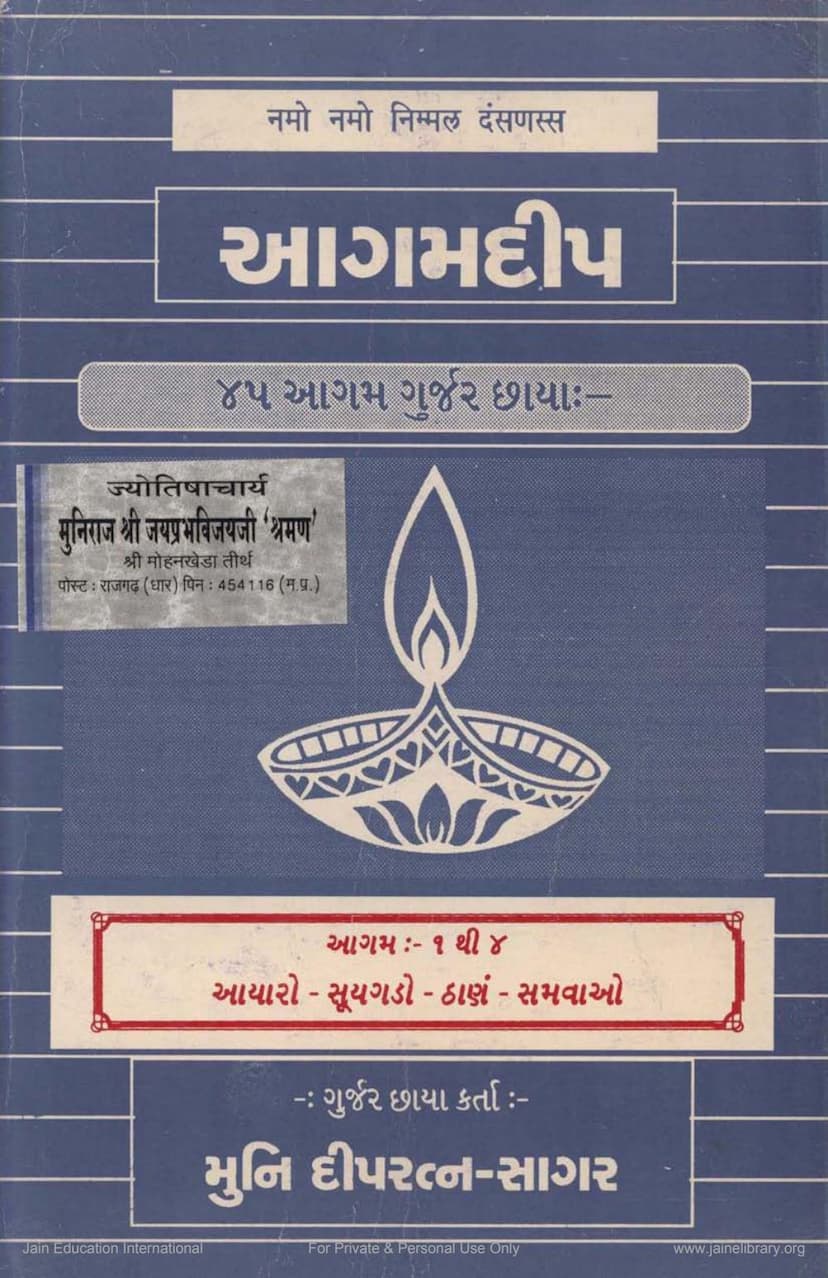Agam Deep 39 Mahanisiham Gujarati Anuvaad
Added to library: September 1, 2025

Summary
Here's a comprehensive summary in English of the Jain text "Agam Deep 39 Mahanisiham Gujarati Anuvaad," based on the provided pages:
Book Title: Agam Deep 39 Mahanisiham Gujarati Anuvaad Author(s): Dipratnasagar, Deepratnasagar Publisher: Agam Shrut Prakashan Catalog Link: https://jainqq.org/explore/005102/1
Overall Context: This text is a Gujarati translation and commentary ("Gurjar Chhaya") of the Jain Agam scripture, Mahanishih (Mahanisiham). It is part of a larger series called "Agam Deep" which aims to provide these ancient Jain texts with a Gujarati rendering. The Mahanishih is identified as the sixth Ched Sutra. The provided pages focus heavily on the first chapter (Adhyayan 1) of the Mahanishih, which deals with "Shalya Uddharan" (removal of splinters/inner afflictions) and subsequent chapters, including Karma Vipaka (consequences of actions), Kushil Lakshana (characteristics of the unvirtuous), and Kushil Sansargi (association with the unvirtuous).
Key Themes and Content:
-
Core Jain Principles: The text begins with invocations to the pure teachings ("Nirmal Deshans") and to the Tirthankaras and revered Acharyas, establishing the spiritual foundation of Jainism. It emphasizes the importance of Right Faith, Right Knowledge, and Right Conduct (Ratnatray).
-
Mahanishih - The Great Night/Prohibition: The title itself suggests a focus on strict prohibitions and the consequences of their violation. The text delves into the detailed conduct expected of monks and nuns, particularly concerning their spiritual practices, purity, and avoidance of worldly attachments and flaws.
-
Shalya Uddharan (Removal of Inner Afflictions): A major theme is the identification and removal of "shalya" or inner afflictions. These are presented as subtle impurities that hinder spiritual progress. The text elaborates on the various forms of shalya, including those related to:
- Kashayas (Passions): Anger, pride, deceit, and greed are discussed as primary sources of shalya.
- Gauuravs (Egos/Arrogances): The text mentions three types of gauuravs related to Riddhi (supernatural powers), Rasa (nectar/flavor), and Shaata (comfort/pleasure).
- Other Flaws: These include various forms of misconduct, attachment, aversion, false beliefs, non-abstinence, misuse of speech and body, association with the unvirtuous, slander, false accusations, conflict, and forms of pride.
- The text stresses the need for absolute eradication of these shalyas, even in the subtlest form.
-
Tapa (Austerities) and Sanyam (Discipline): Intense and rigorous austerities (Tapa) and strict discipline (Sanyam) are highlighted as essential for removing shalya and achieving spiritual purification. The text describes various forms of Tapa and the mental fortitude required for their practice.
-
Consequences of Actions (Karma Vipaka): A significant portion of the text details the karmic consequences of actions, especially those arising from shalya and unvirtuous conduct. It illustrates how even minor transgressions can lead to severe suffering across lifetimes, including rebirths in lower realms (hells, animals) and experiencing debilitating physical and mental afflictions. The text paints a grim picture of the cycle of birth and death driven by karma.
-
The Path to Kevalgyan (Omniscience) and Moksha (Liberation): The text frequently contrasts the suffering caused by shalya and flawed conduct with the path to liberation (Moksha). It emphasizes that true spiritual progress and the attainment of Kevalgyan and Moksha are only possible through the complete removal of shalya, coupled with virtuous conduct, disciplined practices, and profound spiritual understanding. The text lists numerous ways in which Kevalgyan can be attained, often through intense self-control and adherence to principles, even in seemingly minor actions.
-
The Nature of Suffering: The text provides vivid descriptions of the suffering inherent in the worldly existence across different life forms (humans, animals, hell-beings, celestial beings), underscoring the transient nature of worldly happiness and the pervasive nature of suffering due to karma.
-
The Importance of Correct Conduct and Association: The text strongly warns against the company of the "Kushil" (unvirtuous or those with flawed conduct) and emphasizes the need for association with virtuous individuals and adherence to the teachings of the Tirthankaras. It illustrates with narratives how wrong association can lead to spiritual downfall.
-
The Role of the Guru and Proper Learning: The text highlights the crucial role of a qualified Guru in understanding and practicing the Agam scriptures. It emphasizes the need for proper learning, adherence to rituals (like Upadhan), and avoiding any deviation from the Guru's teachings. The concept of "Gachhadhipati" (leader of a sect) and the importance of adhering to their guidance are also present.
-
Detailed Descriptions of Flaws: The text provides exhaustive lists of different types of flaws, their characteristics, and their karmic repercussions. This includes detailed classifications of knowledge-related flaws (Gyan Kushil), conduct-related flaws (Charitra Kushil), and various other forms of misconduct and attachment.
-
Examples and Narratives: The text uses stories and examples, like the narrative of Sumati and Nagil, and the cautionary tale of the character "Savdhyacharya," to illustrate the principles and the dire consequences of deviating from the path.
-
Specific Practices: Mention is made of practices like Upavas (fasting), Ayambil (a specific type of fasting), reciting the Navkar Mantra, and engaging in specific austerities, all within the framework of removing shalya and purifying the soul.
Structure and Format: The text is presented as a Gujarati translation with a "Gurjar Chhaya" (commentary or explanation in Gujarati). It is organized into Adhyayans (chapters) and Uddeshas (sections). The page numbers and section references provide a glimpse into the detailed structure. The publication details and acknowledgments on the initial pages indicate a conscious effort to preserve and disseminate Jain Agam literature. The presence of acknowledgments for financial support (e.g., Smt. Naynaben Rameshchandra Shah Parivar) indicates the collaborative nature of such religious scholarly works.
In essence, the Mahanishih, as presented in this "Agam Deep" series, serves as a profound guide to the rigorous spiritual path outlined in Jainism. It details the pitfalls of internal and external impurities (shalyas and kushils) and the grave karmic consequences, while simultaneously pointing towards the arduous but ultimately liberating path of Tapa, Sanyam, and right conduct for achieving Moksha.